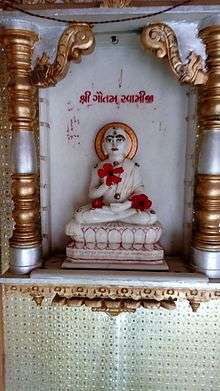Indrabhuti Gautama
| Gautama Ganadhara | |
|---|---|
.png) Miniature of Indrabhuti Gautama seated, in the typical Śvetāmbara monastic dress and holding a rosary, 15th century | |
| Personal information | |
| Parents |
|
_Wellcome_L0034107.jpg)


| Part of a series on |
| Jainism |
|---|
 |
|
Jain prayers |
|
Ethics |
|
Major sects |
|
Festivals |
|
|
Indrabhuti Gautama or Gautam Swami was the Ganadhara (chief disciple) of Mahavira, the 24th and last Jain Tirthankara of present half cycle of time.[1] He is also referred to as Gautama Gandhara or Gautama Swami.
Name
His birth name was Indrabhuti Gautama. He was commonly referred by his gotra, Gautama. He is often referred to as Goyam in Prakrit scriptures.
Birth
He was born in the Gochchar village in the Magadha kingdom to a Brahmin couple, Vasubhuti and Prithvi.
Digambara Tradition
According to Shatkhandagama, the digambara scripture, the Indra, pretending to be a medicant, approached Indrabhuti. The Indra asked him to explain the meaning of a verse:
पंचेव अत्थिकाया छज्जीव णिकाया महव्वया पंच|
अट्ठयपवयण-मादा सहेउओ बंध-मोक्खो य||
When he was unable to explain the verse, the Indra advised him to visit the samavasarana of Lord Mahavira so that he can learn the meaning of the verse. As he was approaching the set of Lord Mahavira at his gandhakuti, he saw the lofty manastambha (the column of pride). Seeing the manastambha, his pride vanished and he was filled with humility. He became the chief disciple of Lord Mahavira at the age of 50. The day he took diksha is celebrated as Guru Purnima. His brothers Agnibhuti and Vayubhuti, both scholars of distinction, also became Ganadharas of Lord Mahavira.
Svetambara Tradition
According to the elaboration of Debate with the Ganadhara by Jinabhadra, the learned Brahmin Gautama summoned the gods to a great sacrifice but instead they flew off to hear Mahāvīra preaching at his second samavasarana near by.[2] In fury, Gautama confronted Mahavira in debate, as did ten other brahmins in succession, with the fordmaker converting them all by a demonstration, underpinned by his claim to omniscience.[2]
According to Svetambara texts, Gautama had a meeting with Keśī (ganadhara of Parshvanatha).[3]
Beliefs
Gautama is connected with prosperity as he fed some monks using his magical powers.[4]
Svetambaras write Gautama's name in new account books as a sign of auspiciousness in the new year.[4]
In literature
Gautama is mentioned in the Exposition of Explainations, as an interpreter of Mahavira.[2] It is further mentioned that they have been friends in their previous incarnations and will attain moksha in the one which they are now.[2]
See also
Notes
- ↑ Teerthankar mahaveer aur unki acharya parampara by Dr. Nemi chandra shastry, Sagar, 1974 vol-1-4.
- 1 2 3 4 Dundas 2002, p. 37.
- ↑ von Glasenapp 1999, p. 35.
- 1 2 Dundas 2002, p. 39.
References
- Dundas, Paul (2002) [1992], The Jains (Second ed.), Routledge, ISBN 0-415-26605-X
- Outline of Jainism by S.Gopalan, published by Waily Estern Ltd.,New Delhi-110016 in 1969
- Jaina Sutras , Translated from the Prakrit by Hermann Jacobi, 1884
- Source at http://www.AtmaDharma.com
- Scriptures